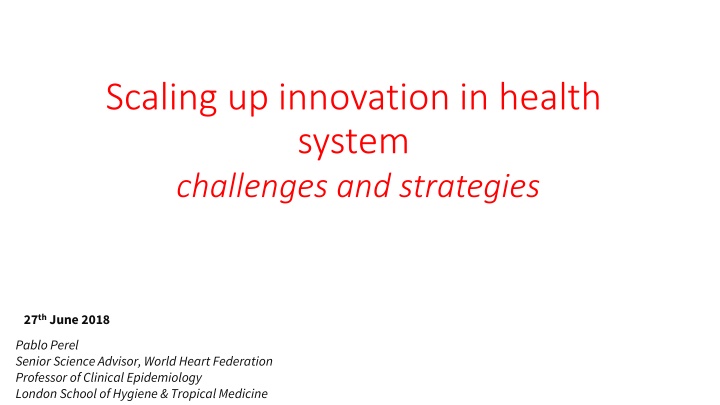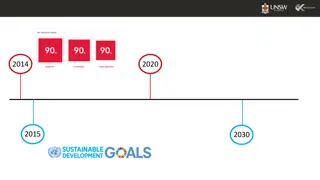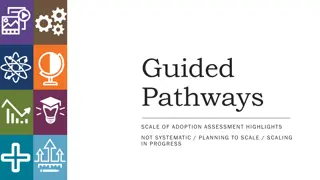Challenges and Strategies in Scaling Up Innovation in Health Systems
Pablo Perel, Senior Science Advisor at the World Heart Federation, discusses the challenges and strategies involved in scaling up innovation in health systems. The content covers evidence-based medicine, implementation research, and the complexities of definitions and frameworks in health systems research. It also delves into the importance of bridging the gap between evidence and practice through implementation research.
Download Presentation

Please find below an Image/Link to download the presentation.
The content on the website is provided AS IS for your information and personal use only. It may not be sold, licensed, or shared on other websites without obtaining consent from the author.If you encounter any issues during the download, it is possible that the publisher has removed the file from their server.
You are allowed to download the files provided on this website for personal or commercial use, subject to the condition that they are used lawfully. All files are the property of their respective owners.
The content on the website is provided AS IS for your information and personal use only. It may not be sold, licensed, or shared on other websites without obtaining consent from the author.
E N D
Presentation Transcript
Scaling up innovation in health system challenges and strategies 27th June 2018 Pablo Perel Senior Science Advisor, World Heart Federation Professor of Clinical Epidemiology London School of Hygiene & Tropical Medicine
Lost in definitions & frameworks Health systems research, Health policy research, Implementation research, Implementation science, Dissemination & Implementation, Knowledge translation, Innovation Population health intervention research. Knowledge translation gap Know do gap, Evidence practice gap, Delivery science, Scale-up, Integration Hundreds of different definitions for implementation, scale up, innovation, integration, frameworks, theories, model, tools, etc.
Same words to refer to different concepts Different words to refer to the same concept what is important is not what does a word mean what is important is not what does a word mean but what do you mean by that word but what do you mean by that word
Research phases Sampson Global Heart 2016
Implementation research Is the systematic study of how a specific set of activities and designed strategies are used to successfully integrate an evidence-based public health intervention within specific settings . Schillinger, D. 2010 Implementation research investigates the various factors that affect how a new policy or intervention may be used (or implemented) in real-life settings. WHO 2016 the systematic study of how a specific set of activities and designated strategies are used to successfully integrate an evidence-based public health intervention within specific settings CDC
Implementation Research Research that quantifies the scale of the gap: full use of an intervention Address the gap between evidence and practice Research that identifies the reasons for this gap: variables or processes that influence the adoption of health interventions into routine practice Research that identifies interventions to close this gap: methods to promote the systematic uptake of evidence based knowledge and practice into routine practice Research that focuses on the interaction between the intervention and the context and does not isolate the effects of the intervention from the context and use different methods Research that that aims to produce generalizable knowledge that can be applied across settings and contexts.
Implementation research Improved implementation strategies Implementation Research Current Inefficient implementation strategies Efficacy Coverage Impact
Scale-up deliberate efforts to increase the impact of health service innovations successfully tested in pilot or experimental projects so as to benefit more people and to foster policy and programme development on a lasting basis. Brownson, Colditz and Proctor. 2017 Dissemination and Implementation Research in Health
Scale up Most commonly refers to coverage of interventions; however, it can also refer to financial, human, and capital resources Requires a combination of horizontal (e.g., replication and expansion) and vertical (institutional, policy, political, legal) scaling up efforts, which benefit from different D& I strategies Is a process within the health system
Innovation an idea, practice, or object that is perceived as new by an individual or other unit of adoption (Rogers 1983) Technical, organizational or social innovation 3 key aspects of innovation Novelty Added value Discontinuous change Innovations might have undesirable consequences
Challenges to scale up of innovations It is not a one time event Interlinked and overlapping processes Iterative Different actors at different point in time with different roles Involves discontinuous change in behaviours Complex processes (non-linear relationships) Require context specific adaptations
Determinants of scale up Health innovation Users Scale-up Broad political and social context Organization
Strategies to promote scale-up designing scalable innovations planning for scale-up persuading government to accept, adopt and finance innovations at scale supporting and enabling organizations to scale-up; and promoting community acceptance and uptake of innovations providing accurate and timely feedback
Scale-up designing scalable innovations planning for scale-up persuading government to accept, adopt and finance innovations at scale supporting and enabling government to scale-up; and promoting community acceptance and uptake of innovations providing accurate and timely feedback
Scalable innovation Adapted to the local context Simple Low-cost (cost-effectiveness) Relevant problem needs Effective & advantageous (comparative advantage) Visible benefit on important outcomes Acceptable by community and health workers (early involvement of stakeholders)
Scale-up designing scalable innovations planning for scale-up persuading government to accept, adopt and finance innovations at scale supporting and enabling organizations to scale-up; and promoting community acceptance and uptake of innovations providing accurate and timely feedback
Planning for scale up Embedding scale-up in programme design; Building implementer capacity to catalyse scale-up Staff capacity. Reputation Leadership Networks
Scale-up designing scalable innovations planning for scale-up persuading government to accept, adopt and finance innovations at scale supporting and enabling organizations to scale-up; and promoting community acceptance and uptake of innovations providing accurate and timely feedback
Persuading government to accept, adopt and finance innovation adopting effective approaches to advocacy (continue, at different levels and formats) Presenting evidence (different type of evidence, robust) Involving government (early involvement in question & design) Invoking policy champions and networks Harmonisation (take into account different initiatives) Policy alignment ( government priorities)
Scale-up designing scalable innovations planning for scale-up persuading government to accept, adopt and finance innovations at scale supporting and enabling organizations to scale-up; and promoting community acceptance and uptake of innovations providing accurate and timely feedback
Supporting government for scaling up Dedicated and ongoing resources including Funding Technical assistance to draft Policies, Guidelines Protocols Training curricula
Scale-up designing scalable innovations planning for scale-up persuading government to accept, adopt and finance innovations at scale supporting and enabling organizations to scale-up; and promoting community acceptance and uptake of innovations providing accurate and timely feedback
Promoting community acceptance Work with community opinion leaders Community groups Mass local media Avoid top-down (involve community from the beginning)
Strategies to promote scale-up designing scalable innovations planning for scale-up persuading government to accept, adopt and finance innovations at scale supporting and enabling organizations to scale-up; and promoting community acceptance and uptake of innovations providing accurate and timely feedback
Providing feedback Accurate and timely information feedback is fundamental Continued evaluation Frame evidence different for different stakeholders Trade-off between what is desirable and feasible
Conclusions 1 Scaling up is a complex social political process Key determinants are related with the health innovation, the users, the organization and broad social-political context Different perspective (users, decision makers, health care providers, researchers) For decision makers scale-up is a continuous iterative process (our research is just a small part of it)
Conclusions 2 From a researcher perspective key aspects to consider for scale up of health innovation are Design scalable intervention Involve stakeholders early on the process Consider the context and how the intervention needs to be adapted Measure relevant outcomes across the different health system building blocks Measure why and how things work (or did not work) Conduct implementation research (use mixed methods) Report the evidence in different formats for difference audience Promote inter-disciplinary work
Knowing is not enough; we must apply. Willing is not enough; we must do. Goethe























